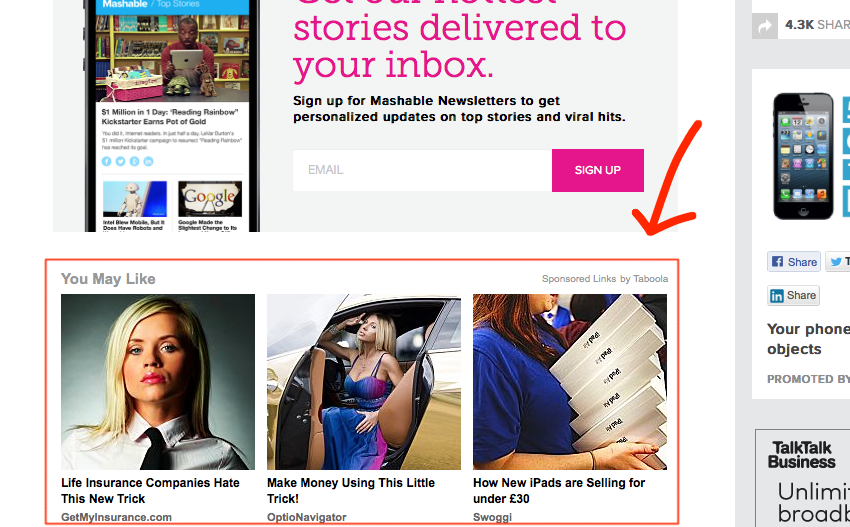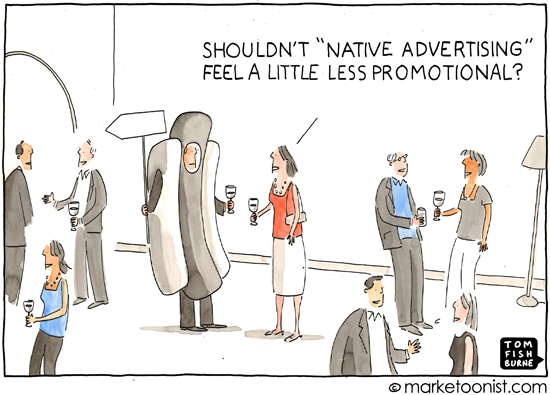If you’ve ever spent more than ten minutes browsing online, you’ll have seen examples of native advertising even if you didn’t recognize it at the time. Really, that’s the beauty of it.

Because of this, native advertising is an extremely hot commodity right now, despite the fact that defining what the term means – much less trying to identify it – can be a very tricky prospect.
In order to do this, let’s take a look at what native advertising isn’t.
Traditional Advertising
The umbrella of ‘traditional advertising’ is a fairly large one, and encompasses over a century of various methods marketers have invented to try and get your attention (and, by extension, sell you stuff).
- In the very ‘traditional’ sense, this typically comprises print magazine adverts, billboards on the side of the road, physical mailshots and even salesmen going door to door or selling their wares at stalls in public locations (although this is notably anachronistic). Outlandish approaches such as advertising via the Goodyear Blimp can technically be classed as traditional advertising, too.
- Web advertising has also come in numerous forms over the years – and given that spam and pop-ups can be counted among them, the Internet has arguably also given rise to the most annoying. On the more legitimate end of the spectrum, traditional web advertising mainly incorporates banner ads and email subscription broadcasts.
- Broadcast advertising, unlike its peers, has remained relatively unchanged over the years and mainly revolves around video ads played in and around other broadcast content. The lines between web and broadcast advertising is blurred, of course, given that the web can be a platform for broadcast journalism (think Youtube pre-roll advertising, for instance).
All of these methods of advertising have one thing in common, and it’s the one thing that distinguishes traditional advertising from native advertising. Problem is, it’s not a good thing.
The Problem With All of the Above
Traditional forms of advertising are the ones we’ve all come to know and… well, avoid.

In a world saturated with advertising, consumers are extremely well trained to spot adverts and ignore them. In fact, they’ve become classically conditioned to do so, and it has become a game of diminishing returns for marketers – back in 2000, the clickthrough rate for banner adverts was a respectable 9% of visitors on average.
As of 2012, that rate has plummeted to 0.2%.
If consumers will only read, watch, and click on what they’ve come to see, surely the best approach is to make them want to see an advert? This is where native advertising comes in.
What Native Advertising Is (and Why it Works)
The specific definition varies from person to person, but possibly the most concise description comes from the guy who coined the term. Following on from a talk in 2011 which gave rise to the initial idea, marketing CEO Dan Greenberg ran with the concept and summed it up as “a form of media that’s built into the actual visual design and where the ads are part of the content.”
In a nutshell, native marketing is:
1) An ad that is intrinsic within the design of the content (whatever that content may be)
2) The design of the advert augments the user experience rather than detracts from it
3) Optionally, the advert can be the content itself
This may sound complex in theory and filled with a lot of marketing buzz words, but in practice, it’s fairly straight forward. Think of promoted tweets on Twitter or ‘suggested posts’ on Facebook – they work within the confines of the platform, don’t interrupt the flow of content, and can actually be classed as content themselves.
Want an even more overt example? You’ll have seen these all over the web:

These ads are auto generated by the Taboola network – this particular example comes from Mashed, but can be seen pretty much everywhere. Of course, those links are very clearly advertorial in nature (with clinically-designed titles to maximize click-through) but they segue into the main design of the site and, at first glance, just look like more articles to check out after you’ve finished the one you’re on.
If you want to boil the definition down to its bare bones, native advertising is simply “sponsored content that looks good.”
 The benefits of native advertising are obvious. For the most part, it doesn’t take away from the user experience, and the marketer on the other side of the desk can expect better engagement.
The benefits of native advertising are obvious. For the most part, it doesn’t take away from the user experience, and the marketer on the other side of the desk can expect better engagement.
Given this, it’s no surprise that native advertising is a growing field. As discovered in a Copyblogger survey:
- Three out of four publishers offer some form of native advertising on their sites
- 90% of publishers either have or plan to launch native advertising campaigns
- 41% of brands are currently using native advertising as part of wider promotional efforts
But it’s far from a magic bullet. Also revealed in the survey is that half of all consumers have no idea what native advertising is, and half of those that do are highly skeptical of it.
So now that we’ve discussed what native advertising is (and is not), let’s take a look at how it should be done properly. Check out our “Ten Commandments of Native Advertising.”